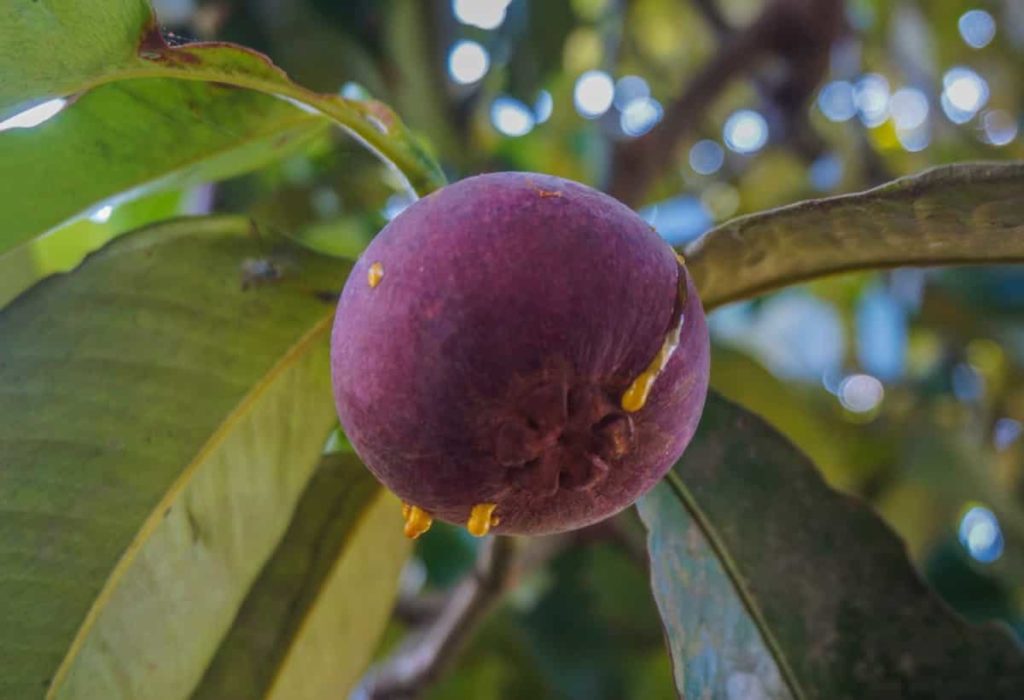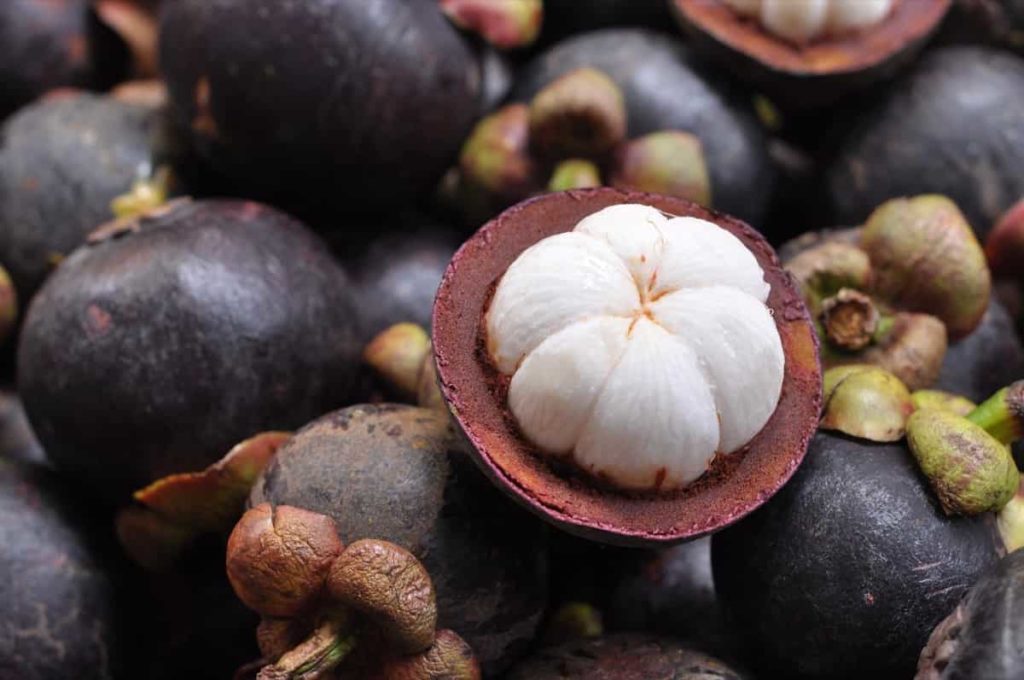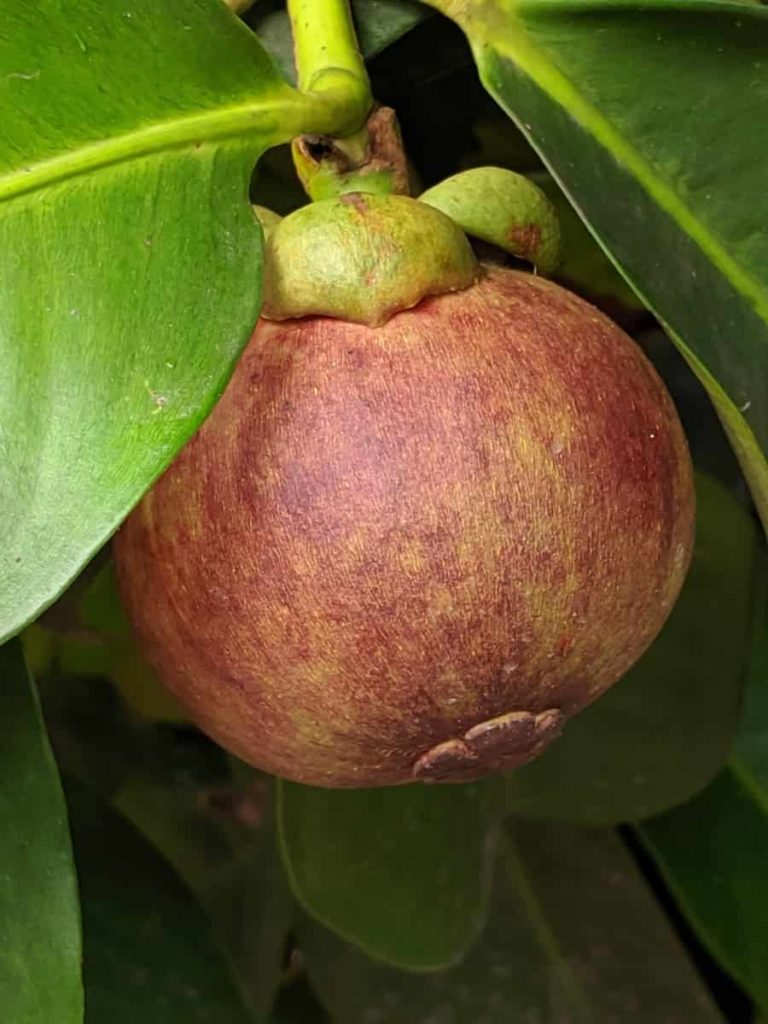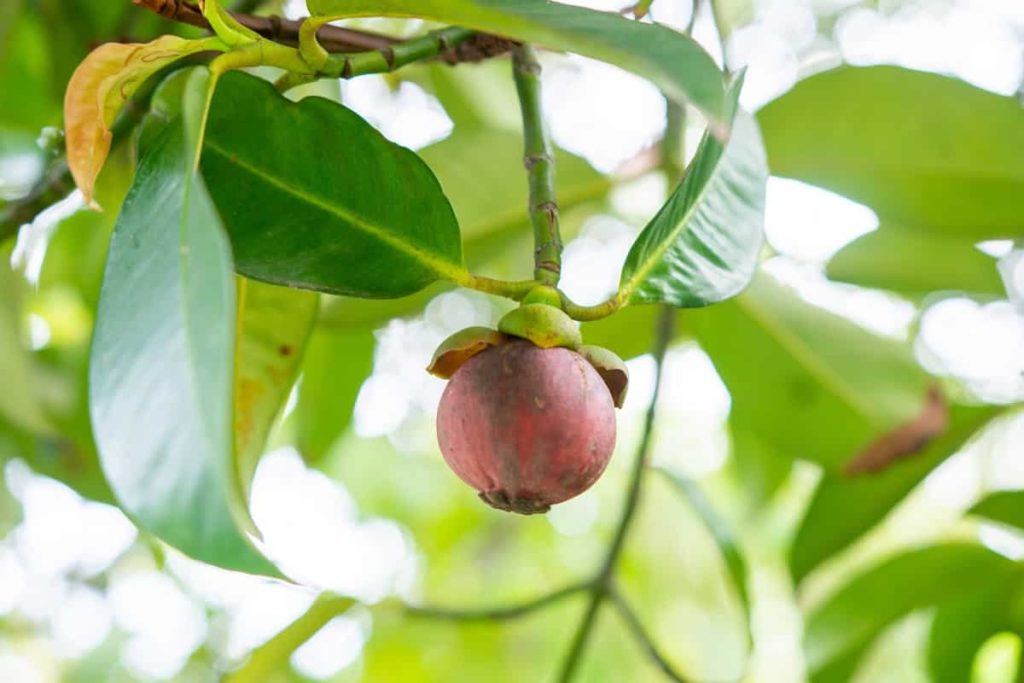Small, purple Mangosteen originates in Southeast Asia. Soft, white, delicious flesh covers a rigid exterior shell. A mix of pineapple, strawberry, peach, and lychee flavor has been described by many who have tried it. An upright, pyramid-shaped crown is typical of the Mangosteen tree’s environment, which is slow-growing and upright. With a black outer bark, the tree can reach 20-82 feet.

Its bark contains a sticky, exceedingly bitter latex. Short-stemmed, dark green leaves with rectangular and glossy tops and yellow-green and dull undersides are found on this evergreen tree. In addition, there are reddish-orange, oval new leaves. Thailand, the Philippines, Sri Lanka, Malaysia, and Indonesia are among the countries where farmers often grow mangosteen. People in these nations eat it as a fruit and use it medicinally. Let’s find out how to grow Mangosteens from seeds.
Two factors make it difficult to locate fresh Mangosteen. To begin with, Mangosteen trees need a tropical environment and a long growing period. Starting in the 1990s, small farms in Hawaii and Puerto Rico are just now beginning to yield fruit. It is also possible that quarantine or non-native bugs may be present in fresh Mangosteen. Therefore, before entering other countries, Mangosteen importers must disinfect the fruits. Some products suffer as a result because of this.
How to grow Mangosteens from seeds
Seed selection
For sowing, look for plump seeds and wholly formed in ripe fruit. Before sowing, Mangosteen seeds should be separated from their fruits. Moist peat moss or sphagnum moss is commonly used to ship bought seeds, which are then placed in airtight containers or sacks. To fasten the germination of your seeds, soak them in clean water for at least 24 hours before planting.
Soil requirements for growing Mangosteens
The tree thrives on soil that is rich in nutrients, permeable, and well-draining. Clay soil with an equal amount of sand and silt performs best. Mangosteen will do even better on soils that have a somewhat acidic pH.
In case you missed it: Guide to Growing African Violets from Seeds: Problems, Plant Care

Planting the Mangosteen seeds
The Mangosteen seed should be planted at least 8 inches deep in a rich, organic, sandy loam-enriched soil with organic compost. A minimum of four feet of soil is required. There are normally 20 to 22 days of sprouting until it’s done. A minimum of 2 years is needed for the seedlings to reach 12 inches in height. Once the sapling reaches at least 2 feet in height, you can gently transplant it.
Temperature regulation
Maintain a constant temperature of at least 50 degrees Fahrenheit and a maximum of 100 degrees Fahrenheit at all times. Protect the Mangosteen seedlings and saplings from any wind or gusts.
Growing and caring for your Mangosteens
If you can reproduce the understory conditions of a tropical rainforest, you’re in business; if not, a 50% shade cloth will suffice. Young trees enjoy some shade while getting established. Mangosteens are slow-growing trees that bear fruit after nine to twelve years in optimal circumstances and up to twenty years in less favorable ones. Without the right circumstances, Mangosteens will fail and perish. According to studies, even in humid, moist settings where the tree flourishes, seedlings may be killed by standing water.
Temperatures below 45 degrees Fahrenheit might cause Mangosteens to wilt. Salt spray, sandy soil, and high-salt soil are all factors that contribute to the death of trees in Florida’s warmer climes. There must be enough humus in the soil to support them. Purdue reported that commercial crops have thrived on clay soil in India.
In case you missed it: How to Grow Bermuda Grass from Seeds: Germination Process

Watering your Mangosteens
Keep the Mangosteen’s soil wet at all times by regularly watering it. Ensure that the seedlings, saplings, and mature trees are kept in an area or pots, with a yearly rainfall of a minimum of 55 inches. The Mangosteen should not be subjected to saltwater or salty heavy tap water, such as hardened water, while it is being processed.
Propagation of Mangosteens
There have been several efforts with grafting, but seed propagation is the most common method. A real seed is a hypocotyl tubercle since there has been no fertilization. To propagate seeds, they must be utilized within five days after being removed from the fruit and sprout in 20-22 days. It is best to start the seedling in an area where it will remain for at least two years before trying to move it, owing to the seedling’s lengthy, sensitive taproot. When the tree is 10-20 years old, it is more likely to bear fruit than if it is younger.
Mangosteen fertilizer requirements
Once every 4-5 months, treat the plant with a 20-20-20 or 20-15-20 fertilizer to keep it healthy. Continue fertilizing the tree until it reaches the age of 3-4 years. If you want to grow organic fruits, you may use just the manure to save money. Alternatively, you may use fish emulsion to treat the sides of the plant. Once the tree has established itself, you will no longer need to provide it with food.
Take care of pests
Because the Mangosteen tree’s bark contains bitter latex, pests and pathogens have a problematic time invading the tree. Nonetheless, keep an eye out for leaf-eating caterpillars. Alternatively, they can be manually harvested and squished.
Harvesting of Mangosteens
According to Tradewinds Fruit, there are just a few days in which you may keep the seeds viable after collecting them yourself. Seeds that are large and fully grown have the greatest germination rates. Soak the seeds for 24 hours to improve their chances of germinating. Seeds germinate within 2 to 3 weeks after being sown in the ground.
In case you missed it: Fast Blooming Flowers to Grow from Seeds: Indoors, Pots, Backyard, and Raised Bed

A lengthy taproot forms early on in the newborn seedling. Keep the lengthy root intact while transplanting since it is essential for establishing the tree. You will almost certainly fail if you attempt to transplant a Mangosteen seedling after it has grown more than 2 feet in height. As a result, it’s best to put it in the ground as soon as possible.
Frequently asked questions about Mangosteens (FAQ)
How mangosteens can be useful?
By dilating blood arteries, Mangosteen promotes proper blood flow to all body organs, notably the heart. Mangosteen’s hypotensive properties are very beneficial in treating high blood pressure symptoms like strong high blood pressure headache, tension, and palpitations. It also helps to maintain normal blood pressure by regulating the number of triglycerides in the blood and controlling the heart rate.
In this way, it is pretty efficient in preventing severe cardiac problems such as chest discomfort and congestive heart failure. In addition, Mangosteen has a high concentration of vitamin C, which provides beneficial antioxidant characteristics and the ability to create a robust immune system. Antioxidants prevent dangerous free radicals from harming the body’s healthy cells, while antibodies, and proteins, protect the body against viruses that cause illnesses such as pneumonia, influenza, and the common cold.
How long does Mangosteen take to bear the fruit?
It depends on many factors such as care, soil type, climate, and growing method, However, you can expect it to bear fruits from the 7th year of planting. Some trees start bearing fruits after 10 to 12 years. For early fruiting, make sure to provide soil nutrients along with proper pruning and fertigation.
In case you missed it: Garden Vegetable Seeds for Rainy Season

How many seeds are in Mangosteen?
It has a blackish-purple fruit skin with 7-8 white segments and 1-2 seeds that can be utilized for plant propagation.
Can you grow Mangosteen in India?
It is only in India’s southern states where most Mangosteen trees, a tropical evergreen, are cultivated. Kerala is India’s biggest Mangosteen grower, with 1,000 tonnes produced annually. Kerala is followed by Tamil Nadu, where an estimated 200 tonnes of Mangosteen are produced annually in Pollachi, the Upper Palani Hills, and Coonoor.
What is the best fertilizer for Mangosteens?
For best results, use an organic fertilizer such as fish emulsion or a diluted solution of balanced plant food such as one with an N-P-K ratio of 16-16-16 every 3 to 4 months. Once your tree reaches the age of three, you should only fertilize it once or twice every year after that.
Up to how much height can Mangosteen grow?
The tree may reach a height of up to 25 meters. While the flesh of citrus fruits is packed with fluid-filled vesicles like the flesh of Mangosteen, the Mangosteen’s outer layer has an inedible, deep reddish-purple color when it is mature.
Do Mangosteen plants need shade to grow?
Even in the shadow, Mangosteens thrive. However, plants still growing cannot withstand direct sunshine, unlike mature trees. Consequently, place your plants in the shadow or a filtered or indirect light location. Up to 13 hours a day are required for plants to thrive on average.
In case you missed it: Garden Vegetable Seeds for Summer

What are the disadvantages of Mangosteens?
Blood clotting may be slowed by Mangosteen. People with bleeding problems may have an increased risk of bleeding if they consume Mangosteen. Blood clotting can be slowed by mangosteen. Taking Mangosteen before or after surgery may increase the risk of bleeding.
- Where to Place Indoor Plants in Your Home
- How to Grow Tomatoes Organically at Home: A Comprehensive Guide
- Organic Gardening on a Budget: Low-Cost Methods and Materials
- Gongura Seed Germination and Planting Methods
- Cabbage Seed Germination and Selection
- Broccoli Seed Germination and Selection
- Asparagus Seed Germination and Variety Selection
- Seasonal Flower Gardening: Best Practices for Spring, Summer, Fall, and Winter
- How to Grow Hibiscus from Flower
- Plantation Ideas for Home Decoration: A Beginners Guide
- Flower Garden Designs and Layouts for Beginners
- Planting and Spacing Techniques in Papaya: A Beginner’s Guide
- Growing Gold: Essential Techniques for Planting Pineapples
- How to Make Kalanchoe Plant Bushy: Home Remedies and Solutions
- 11 Reasons Why Your Gardenia is Not Blooming: Home Remedies and Solutions
- Eco Elegance: The Guide to Designing a Drought-Tolerant Landscape
- Gardening on a Slope: Strategies for Hillside Landscaping
- Nourish and Flourish: Top Organic Mulches for Thriving House Plants
- Everything You Want to Know about Indian Mogra Flower: Discover Uses and Growing
- Green Thumb Success: Expert Tips for Cultivating Greenhouse Pumpkins All Year Round
- Maximize Growth & Flavor: The Ultimate Guide to Companion Planting in Herb Gardens
- How to Control Rhododendron Problems Naturally: Home Remedies and Organic Ways to Fix Them
- Natural Magic: The Remarkable Benefits of Cinnamon for Plants
- Best Steps to Revive Dying Tulip with Natural and Organic Treatment
- 10 Reasons Why Your Angel Trumpet is Not Blooming: Remedies and Treatment
- How to Fix Periwinkle Leaf and Flower-Related Problems: Natural Remedies and Solutions
- How to Fix Zinnias Leaf and Flower Problems: Discover Natural and Home Remedies
- Organic Steps to Induce Lemon Tree Flowers: A Comprehensive Guide
- Bloom Booster: Crafting the Perfect Homemade Bougainvillea Fertilizer
- Optimizing Growth: A Guide to Applying NPK Fertilizer for Potted Plants
- 10 Best Homemade Fertilizers for Rubber Plant: DIY Recipes and Application Method
- How to Boost Female Pumpkin Flowers: Effective Steps for More Flowers and High Yields
- Transform Your Indoor Garden: Top Benefits of Pink Salt for Houseplants
- 10 Best Homemade Fertilizers for Peacock Plants (Calathea): Easy DIY Guide
- Unlock Blooms: 9 Reasons Why Your Potted Chrysanthemum is Not Blooming
- 8 Reasons Why Your Potted Hibiscus is Not Blooming: Fix it with Simple Solutions